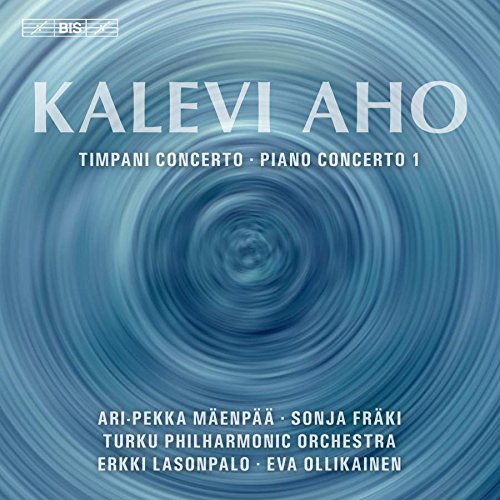AHO Piano Concerto. Timpani Concerto
View record and artist detailsRecord and Artist Details
Composer or Director: Kalevi Aho
Genre:
Orchestral
Label: BIS
Magazine Review Date: 09/2018
Media Format: Super Audio CD
Media Runtime: 60
Mastering:
DDD
Catalogue Number: BIS2306

Tracks:
| Composition | Artist Credit |
|---|---|
| Concerto for Piano and Orchestra No 1 |
Kalevi Aho, Composer
Eva Ollikainen, Conductor Kalevi Aho, Composer Sonja Fräki, Piano Turku Philharmonic Orchestra |
| Concerto for Timpani and Orchestra |
Kalevi Aho, Composer
Ari-Pekka Mäenpäa, Timpani Erkki Lasonpalo, Conductor Kalevi Aho, Composer Turku Philharmonic Orchestra |
Author: Andrew Mellor
Aho’s mystical opening dodges those problems with moderate success, as does his Allegro ritmico third movement (of five), in which sharper sticks get the timps sounding like big booming bongos. Ari Pekka Mäenpää, who workshopped the score with Aho, plays it heroically but it’s difficult not to conclude that these lumbering instruments aren’t charismatic enough to headline a half-hour piece. Even when they really get going in the Presto finale, it’s a little like listening to an old drunk ranting.
BIS, apparently determined to serve Aho in the completist terms it has Sibelius, does well to balance that rather frustrating piece with a rich, rhapsodic and charismatic one (albeit dug up from the archives). Aho’s 1989 Piano Concerto is arranged according to a duodecimal cycle of 16 notes. That cycle is initially arranged into four groups of four (a triad-plus-one) in the first movement before moving to the full cycle of 16 in the second. By the fourth and final movement, we have gravitated to a new 30 note sequence that unravels itself to eventual freedom.
You can ignore the maths and still experience a virile piece with a thrilling, acidic edge (much of the latter coming from flocking woodwinds). The first movement rigidly twists itself up towards a heckelphone deflation, a trajectory that reflects the piece as a whole. The third-movement Toccata is highly mobile, impressively agile and full of textural interest. The second movement and finale legitimise their atmospheres of spacious repose only because of the density of what has gone before. Sonja Fräki negotiates its Scarlatti-like weave with high articulation and tenderness, and the orchestra engages with her.
Discover the world's largest classical music catalogue with Presto Music.

Gramophone Digital Club
- Digital Edition
- Digital Archive
- Reviews Database
- Full website access
From £8.75 / month
Subscribe
Gramophone Full Club
- Print Edition
- Digital Edition
- Digital Archive
- Reviews Database
- Full website access
From £11.00 / month
Subscribe
If you are a library, university or other organisation that would be interested in an institutional subscription to Gramophone please click here for further information.




